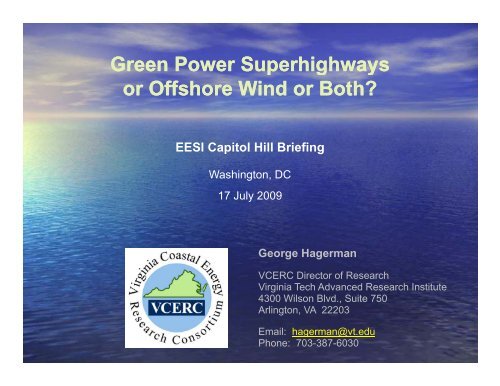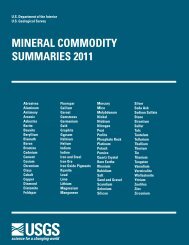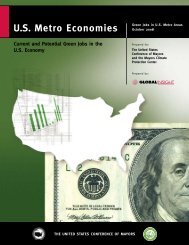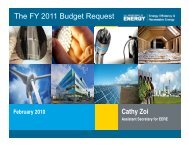George Hagerman - Environmental and Energy Study Institute
George Hagerman - Environmental and Energy Study Institute
George Hagerman - Environmental and Energy Study Institute
You also want an ePaper? Increase the reach of your titles
YUMPU automatically turns print PDFs into web optimized ePapers that Google loves.
Green Power Superhighways<br />
or Offshore Wind or Both?<br />
EESI Capitol Hill Briefing<br />
Washington, DC<br />
17 July 2009<br />
<strong>George</strong> <strong>Hagerman</strong><br />
VCERC Director of Research<br />
Virginia Tech Advanced Research <strong>Institute</strong><br />
4300 Wilson Blvd., Suite 750<br />
Arlington, VA 22203<br />
Email: hagerman@vt.edu<br />
Phone: 703-387-6030
Presentation Outline<br />
Proposal for “Green Power Superhighway” in context<br />
with magnitude <strong>and</strong> distribution ib ti of US wind resources<br />
Offshore wind technology overview<br />
Economic development benefits of offshore wind for<br />
local maritime economies <strong>and</strong> job creation potential<br />
<strong>Energy</strong> security <strong>and</strong> long-term price stability benefits to<br />
U.S Navy; alignment with DOD RPS (25% by 2025)<br />
Ongoing NREL <strong>and</strong> utility modeling of US 20% wind<br />
scenarios will help inform policy making; recommend<br />
exp<strong>and</strong>ing to include economic development impacts<br />
<strong>and</strong> adding other renewable energy resources
Green Power Superhighway Concept<br />
See www.awea.org/GreenPowerSuperhighways.pdf for full report
Nearly 60% of U.S. Population Lives in Atlantic,<br />
Pacific, Gulf of Mexico or Great Lakes States<br />
Twenty-eight coastal states in contiguous U.S. are home to 58% of population
Nearly 80% of U.S. Electricity Dem<strong>and</strong> is in Atlantic,<br />
Pacific, Gulf of Mexico or Great Lakes States<br />
Twenty-eight coastal states in contiguous U.S. consume 78% of U.S. electrical energy
U.S. Offshore Wind Resources<br />
Pacific NW<br />
Class 5, 6 & 7<br />
Gulf of Maine<br />
Class 6<br />
Great Lakes<br />
Class 5 & 6<br />
Mid-Atlantic<br />
Class 5 & 6<br />
S California<br />
Class 4, 5 & 6<br />
Great Plains<br />
Class 3, 4 & 5<br />
Southeast<br />
Class 4, 5 & 6
US Offshore Wind Resources Located<br />
Near Coastal Metropolitan Load Centers
Typical Offshore Wind Farm Layout
Monopile Foundations Driven into Seabed<br />
<strong>and</strong> Transition Pieces Grouted on Top
Horns Rev 2-MW Turbines<br />
Installed Using Self-Propelled A2 SEA Vessels
North Hoyle 2-MW Turbines<br />
Installed Using Towed Seacore Jack-Up Rigs
Two-Thirds of the Capital Cost of an Offshore<br />
Wind Project is in the Turbine & Tower Package<br />
Turbine & Tower Package<br />
66%
Less than One-Eighth of the Capital Cost<br />
is in Submarine Power Cable Fabrication<br />
Turbine & Tower Package<br />
66%<br />
Power Collection: 6%<br />
Power Transmission: 5%
Nearly a Quarter of the Total Project<br />
Capital Investment Engages the Local Economy<br />
Turbine & Tower Package<br />
66%<br />
Power Collection: 6%<br />
Power Transmission: 5%<br />
Project Management<br />
2%<br />
Local Balance of Plant<br />
21%
Wind <strong>Energy</strong> Jobs in the European Union<br />
Breakdown by Type of Activity <strong>and</strong> per Megawatt
Secure <strong>and</strong> Price-Stable <strong>Energy</strong> Supply<br />
for Navy’s Virginia Capes Operating Area
Secure <strong>and</strong> Price-Stable <strong>Energy</strong> Supply<br />
for Navy’s Virginia Capes Operating Area
Secure <strong>and</strong> Price-Stable <strong>Energy</strong> Supply<br />
for Navy’s Virginia Capes Operating Area
Secure <strong>and</strong> Price-Stable <strong>Energy</strong> Supply<br />
for Navy’s Virginia Capes Operating Area
GIS Analysis <strong>and</strong> Mapping of Resource<br />
Focus on 50 MMS lease blocks <strong>and</strong> avoid all excluded areas<br />
MMS lease blocks are<br />
4.8 km x 4.8 km, with each<br />
block having 7 x 7 turbines.<br />
Turbines spaced 685 m<br />
apart (7.6 rotor diameters)<br />
Each lease block could<br />
contain 49 turbines<br />
= 147 MW per block with<br />
Vestas model V-90 3 MW<br />
= 6.4 MW per km 2<br />
GIS layers <strong>and</strong><br />
calculations by<br />
James Madison<br />
University
Class 6 Winds are<br />
Largely Beyond the Visual Horizon<br />
Photo simulation of Long Isl<strong>and</strong> offshore wind project<br />
12 n.mi.
Class 6 Winds are<br />
Largely Beyond the Visual Horizon<br />
Photo simulation of Long Isl<strong>and</strong> offshore wind project<br />
Beyond the<br />
Territorial Sea Limit<br />
of 12 n.mi.,<br />
turbines would<br />
be barely visible,<br />
<strong>and</strong> then only on<br />
the clearest days.<br />
12 n.mi.
Class 6 Winds are<br />
Largely Beyond the Visual Horizon<br />
Photo simulation of Long Isl<strong>and</strong> offshore wind project<br />
Beyond the<br />
Territorial Sea Limit<br />
of 12 n.mi.,<br />
turbines would<br />
be barely visible,<br />
<strong>and</strong> then only on<br />
the clearest days.<br />
12 n.mi.<br />
Total available<br />
area of Class 6<br />
beyond 12 n.mi.<br />
is 575.6 sq.km<br />
(142,500 acres);<br />
could support<br />
3,680 MW of<br />
wind capacity.
U.S. DOE “20% Wind <strong>Energy</strong> by 2030”<br />
ty (GW)<br />
300<br />
250<br />
Offshore<br />
L<strong>and</strong>-based<br />
53.9 GW<br />
offshore<br />
ed Capaci<br />
tive Install<br />
200<br />
150<br />
100<br />
293.4 GW<br />
on l<strong>and</strong><br />
Cumulat<br />
50<br />
2009<br />
0<br />
2000 2006 2012 2018 2024 2030
Ten Eastern States have Shallow-Water<br />
Offshore Wind Resources Comparable to Dem<strong>and</strong><br />
ME<br />
MI<br />
OH<br />
NJ<br />
DE<br />
MA<br />
RI<br />
VA<br />
NC<br />
SC
Ten Eastern States have Shallow-Water<br />
Offshore Wind Resources Comparable to Dem<strong>and</strong><br />
ME<br />
MI<br />
MA<br />
RI<br />
A notional offshore wind build-out to support<br />
the “20% Wind <strong>Energy</strong> by 2030”plan can be<br />
estimated as 5.4 gigawatts in each of these ten<br />
states, or 5,400 MW, to be commissioned<br />
between 2011 <strong>and</strong> 2030. This corresponds to<br />
each state installing one 540 MW project every<br />
two years for the next 20 years, at which time<br />
the first projects will be ready for re-powering.<br />
OH<br />
VA<br />
NC<br />
SC<br />
NJ<br />
DE
Ten Eastern States have Shallow-Water<br />
Offshore Wind Resources Comparable to Dem<strong>and</strong><br />
ME<br />
MI<br />
MA<br />
RI<br />
A notional offshore wind build-out to support<br />
the “20% Wind <strong>Energy</strong> by 2030”plan can be<br />
estimated as 5.4 gigawatts in each of these ten<br />
states, or 5,400 MW, to be commissioned<br />
between 2011 <strong>and</strong> 2030. This corresponds to<br />
each state installing one 540 MW project every<br />
two years for the next 20 years, at which time<br />
the first projects will be ready for re-powering.<br />
OH<br />
VA<br />
NC<br />
SC<br />
NJ<br />
DE<br />
Maritime regional economies in all coastal states would<br />
Maritime regional economies in all coastal states would<br />
benefit, but this economic development potential could be<br />
threatened by federally funded Green Power Superhighway
NREL Eastern Wind Integration<br />
<strong>and</strong> Transmission <strong>Study</strong> (EWITS)<br />
Scenario 1, 20% wind penetration – Lowest Cost Wind: Utilizes<br />
high quality wind resources in the Great Plans, with other<br />
development in the east where good wind resources exist. Total<br />
capacity in MISO, MAPP, <strong>and</strong> SPP approximately 185 GW.<br />
Scenario 2, 20% wind penetration – Hybrid, with Offshore: Some<br />
wind generation in the Great Plains is moved east, with capacity<br />
increased in PJM, NYISO, <strong>and</strong> ISO-NE. Some offshore<br />
development in the Northeast t <strong>and</strong> Mid-Atlantic.<br />
ti<br />
Scenario 3, 20% wind penetration – Load-weighted Wind<br />
Development, Aggressive Offshore: More wind is moved east<br />
toward load centers, with much greater offshore development.<br />
See http://wind.nrel.gov/public/EWITS p <strong>and</strong> www.jcspstudy.org<br />
for further information, including reports <strong>and</strong> presentations
EWITS Scenario 1
EWITS Scenario 2
EWITS Scenario 3
Scenario 1 Annual Load Weighted Wholesale<br />
Power Cost (Localized Marginal Price)
Conclusions <strong>and</strong> Recommendations<br />
Consideration of proposals for a federally subsidized<br />
Green Power Superhighway should carefully weigh<br />
impact on coastal states’ ability to develop their own<br />
secure <strong>and</strong> sustainable energy supplies<br />
Impact on local wholesale power prices is now being<br />
modeled for three “20% US wind” scenarios under<br />
the Eastern Wind Integration <strong>and</strong> Transmission<br />
<strong>Study</strong> <strong>and</strong> results will help inform policy making<br />
EWITS analysis should be exp<strong>and</strong>ed to include impact<br />
on local economic development <strong>and</strong> job creation in<br />
all affected states, as well as adding simulation of<br />
other major renewable energy resources (e.g. solar,<br />
biomass) as an integrated US energy supply system
Thank You!<br />
Any questions?<br />
Email: hagerman@vt.edu







